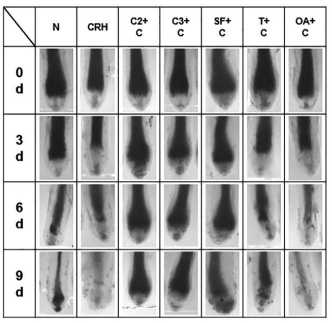2020년 11월 CRH receptor antagonists from Pulsatilla chinensis prevent CRH-induced premature catagen transition in human hair follicles
첨부파일
-
 2020-01 CRH receptor antagonists 10.1111@jocd.13328 남유진.pdf
(1.2M)
4회 다운로드
DATE : 2020-02-25 15:13:48
2020-01 CRH receptor antagonists 10.1111@jocd.13328 남유진.pdf
(1.2M)
4회 다운로드
DATE : 2020-02-25 15:13:48
관련링크
본문
Abstract
Background: There is a growing interest in the relationship among stress hormones, neuroendocrine signaling, and skin diseases, including hair loss. Previous reports showed that stress hormones inhibit human hair growth and induce early catagen transition. Moreover, a CRH receptor antagonist reversed CRH-induced alopecia in a mouse model, suggesting that antagonization of the CRH receptor is a key clinical strategy to treat stress-induced hair loss. Objectives: The aim of this study was to investigate the protective effect of CRH receptor antagonists from Pulsatilla chinensis on human hair follicles (hHFs) and human dermal papilla cells (hDPCs). Methods: hHFs were observed and scored by hair cycle. The levels of cAMP, a second messenger, were measured in each group. In addition, the mRNA and protein levels of factors related to the hair cycle were measured. Furthermore, the expression levels of various members of the mitogen-activated protein kinase (MAPK) signaling pathway related to stress were measured. Results: CRH induced early catagen transition in an ex vivo hair organ culture model. In addition, CRH downregulated the levels of alkaline phosphatase (ALP) and hair
anagen-related cytokines in cultured hDPCs. Moreover, CRH induced the phosphorylation of JNK, c-Jun, p38, ERK, and Akt in cultured hDPCs. CRH receptor antagonists isolated from P chinensis reversed these CRH-induced modulations in both ex vivo hair follicles (HFs) and cultured hDPCs. Conclusions: These results indicate that P chinensis effectively blocks CRH receptor function and that saponin derivatives from P chinensis could be a pharmaceutical and cosmetic approach to treat stress-induced hair loss.
K E Y W O R D S
antagonist, CRH, dermal papilla cell, hair growth, hair loss, Pulsatilla chinensis
Background: There is a growing interest in the relationship among stress hormones, neuroendocrine signaling, and skin diseases, including hair loss. Previous reports showed that stress hormones inhibit human hair growth and induce early catagen transition. Moreover, a CRH receptor antagonist reversed CRH-induced alopecia in a mouse model, suggesting that antagonization of the CRH receptor is a key clinical strategy to treat stress-induced hair loss. Objectives: The aim of this study was to investigate the protective effect of CRH receptor antagonists from Pulsatilla chinensis on human hair follicles (hHFs) and human dermal papilla cells (hDPCs). Methods: hHFs were observed and scored by hair cycle. The levels of cAMP, a second messenger, were measured in each group. In addition, the mRNA and protein levels of factors related to the hair cycle were measured. Furthermore, the expression levels of various members of the mitogen-activated protein kinase (MAPK) signaling pathway related to stress were measured. Results: CRH induced early catagen transition in an ex vivo hair organ culture model. In addition, CRH downregulated the levels of alkaline phosphatase (ALP) and hair
anagen-related cytokines in cultured hDPCs. Moreover, CRH induced the phosphorylation of JNK, c-Jun, p38, ERK, and Akt in cultured hDPCs. CRH receptor antagonists isolated from P chinensis reversed these CRH-induced modulations in both ex vivo hair follicles (HFs) and cultured hDPCs. Conclusions: These results indicate that P chinensis effectively blocks CRH receptor function and that saponin derivatives from P chinensis could be a pharmaceutical and cosmetic approach to treat stress-induced hair loss.
K E Y W O R D S
antagonist, CRH, dermal papilla cell, hair growth, hair loss, Pulsatilla chinensis









